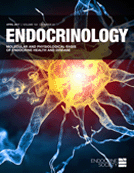-
Views
-
Cite
Cite
JOHN E. NESTLER, JAMES F. McLEOD, MARY A. KOWALSKI, JEROME F. STRAUSS, JOHN G. HADDAD, Detection of Vitamin D Binding Protein on the Surface of Cytotrophoblasts Isolated from Human Placentae, Endocrinology, Volume 120, Issue 5, 1 May 1987, Pages 1996–2002, https://doi.org/10.1210/endo-120-5-1996
Close - Share Icon Share
Abstract
Vitamin D binding protein (DBP), a Mr 56,000–58,000 α2-glycoprotein, is the major serum protein involved in the transport of vitamin D sterols. Recently it has been suggested that DBP may also be involved in immunoglobulin G binding to cells. Because the trophoblast is involved in the transport of molecules such as vitamin D and immunoglobulin G to the fetus, we asked whether DBP could be detected on the surface of human placental trophoblast cells. Cytotrophoblasts purified from human term placentae were fixed and made permeant with Triton X-100 and examined by indirect immunofluorescence after incubation with a monoclonal antibody to DBP. Greater than 90% of these cells stained positively, whereas no staining was observed with nonimmune antiserum. The presence of DBP on/in the surface of cytotrophoblasts could also be demonstrated by fluorescent cytometry. When cell surface-associated proteins of cytotrophoblasts were radioiodinated, a Mr 57,000 radiolabeled protein could be immunoisolated from the cell lysate with a purified monospecific polyclonal antibody to DBP. Immunoisolation of this radiolabeled protein was prevented by the addition of excess unlabeled human DBP to the cell lysate before incubation with antibody. This Mr 57,000 radiolabeled protein could also be isolated by affinity chromatography selecting for proteins that bind to globular actin. When cytotrophoblasts were incubated with [35S]methionine for 3 or 18 h, active synthesis of DBP could not be demonstrated by immunoisolation techniques. These studies demonstrate the presence of DBP on the surface of well washed, human cytotrophoblasts. This DBP may be maternally derived, since active synthesis of DBP could not be demonstrated. (Endocrinology120: 1996–2002, 1987)





